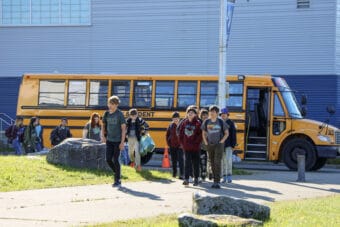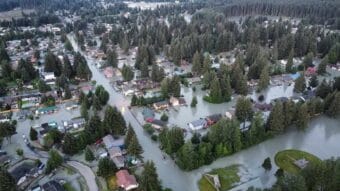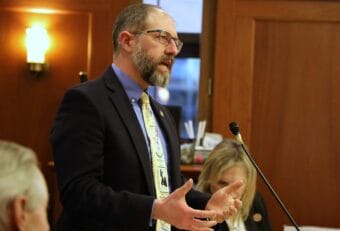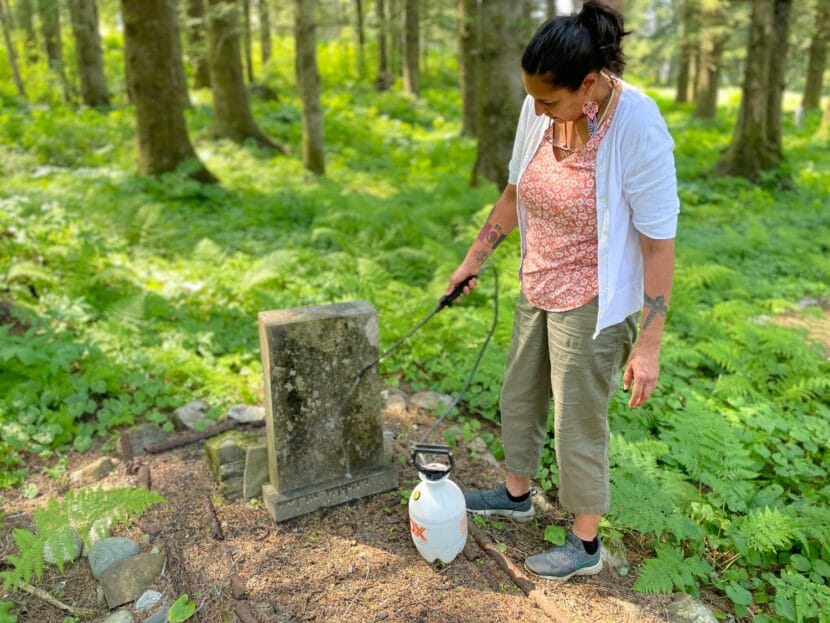
Jamiann S’eiltin Hasselquist plays a song from her phone at a gravesite near Lawson Creek on Douglas Island in Juneau. She rests the phone down on the ground.
“It was a T’aaḵu Kwáan song, the wolf song. I suspect that he’s of the T’aaḵu Kwáan, and so I’ve played the song to honor him and his people, and let him hear it through the ground,” Hasselquist said.
The stone grave marker has a Bible at the very top with the gates of heaven underneath, and a wolf under that. It has two names on it — Kitchoshan and Kakantan. The person was born July 5, 1850, and died June 3, 1901.
This is just one of the hundreds of mostly neglected resting places found off Douglas Highway, around the Lawson Creek area, many of which belong to Native people. Hasselquist is part of a group of volunteers who spends time restoring and uncovering Native gravesites, “not letting them be forgotten and keeping them from being built over,” she said. “We know that that kind of thing happened here.”
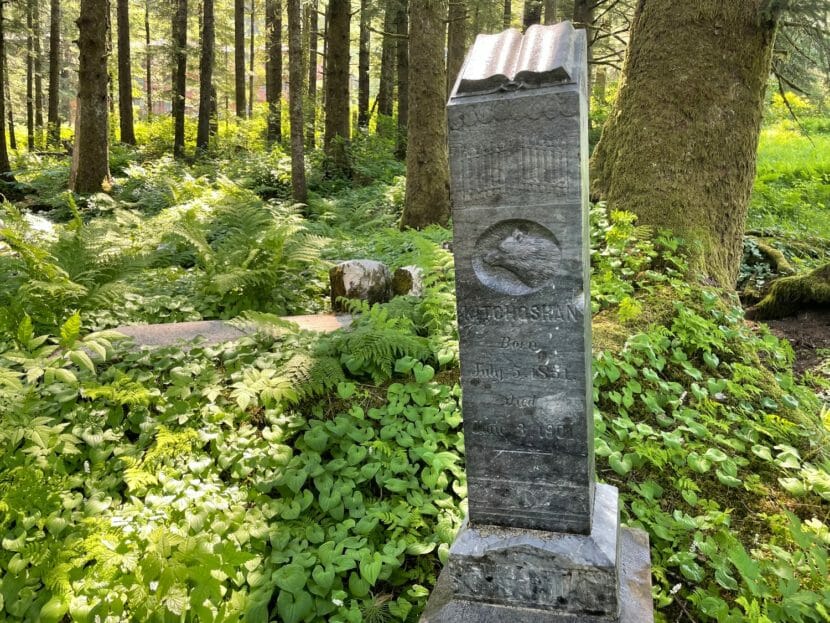
A little further south along Douglas Highway is Sayéik Gastineau elementary school, which was built upon a Native burial ground in the late 1950s.
Since last April, Hasselquist said volunteers have spent hundreds of hours on weekends and in the evenings “chopping their way through” all the growth and foliage — cutting down salmonberry bushes, weed whacking and cutting off tree limbs and old dead trees.
Juneau resident Hanna Schempf is another volunteer.
“You’d whack off enough bushes that you could clear the gravesite you were looking at. And then you’d look through the stems, and you can see other graves just keep going and going and going,” she said.
A 1995 City and Borough of Juneau report on historic cemeteries in Douglas says about 514 graves are within cemeteries that are recognized as “the Catholic, Eagles, Douglas Indian, Masons, Odd Fellows, City, Servian, Asian, Native, and Russian Orthodox.” Today, a few of these sections, like the Eagles and Catholic, are kept up well, but some of the others are not.
The volunteer group has restored or uncovered dozens of Native gravesites, Hasselquist said, including Chief Johnson, chief of the T’aaḵu Kwáan.
“His stone was completely over. We didn’t even know who it was. It was just toppled over,” she said.
Volunteers have found many indentations in the ground though not the markers for each. Some were buried inches underground and uncovered during cleanup. “So we suspect that there are other markers there; we just have to go and find them,” Hasselquist said.
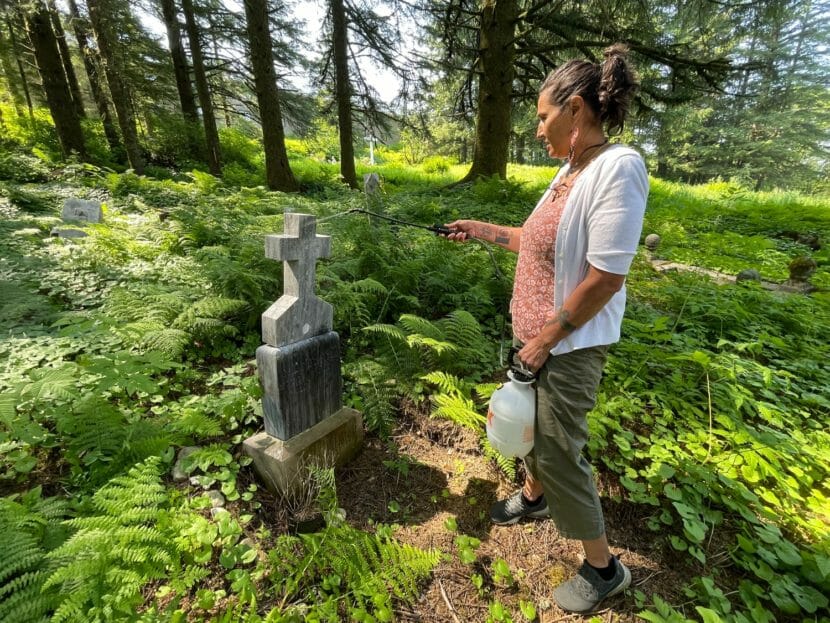
“Everybody deserves a place of rest with honor, dignity and respect,” Hasselquist said. “We all have an inherent right and a responsibility to care for these areas whether we’re related to them or not. This is part of our community.”
‘Neglected, forgotten and destroyed’
Hasselquist was inspired to do this work from Sitka resident and cemetery restoration expert Bob Sam. She first saw his work with Sitka cemeteries on Facebook and later saw it in person. Last April, the two connected when Sam was in Juneau to work on the Lawson Creek cemetery.
For Sam, restoring and maintaining cemeteries — whether in Sitka, Juneau, or Japan — is his life work. “This is something I’ve been doing since I was a small child,” he said. The work is “not a one-time thing. It’s perpetual care.”
Sam, 68, has family buried in Juneau. He first started cemetery restoration in Juneau in the early 1990s at Evergreen Cemetery, specifically the Orthodox Church section. Then he started working at Lawson Creek after learning more about it from Lingít elder Marie Olson.
“The Native section of Lawson Creek was neglected, forgotten and destroyed. Every headstone was knocked down. There was little evidence that they existed,” Sam said. “It took years to cut brush, remove trash, upright headstones just to find the Native section of Lawson Creek. I could not have done this work without support from Elders who also donated tools and stuff.”
Sam said it’s a responsibility to take care and maintain the gravesites of ancestors.
“We’re all human beings and how we treat the dead defines our humanity,” he said. “If a cemetery looks neglected and forgotten, it gets abused. But if you clean it up, make it look real nice, it gets to a point where it takes care of itself, where people pick up after themselves and show respect.”
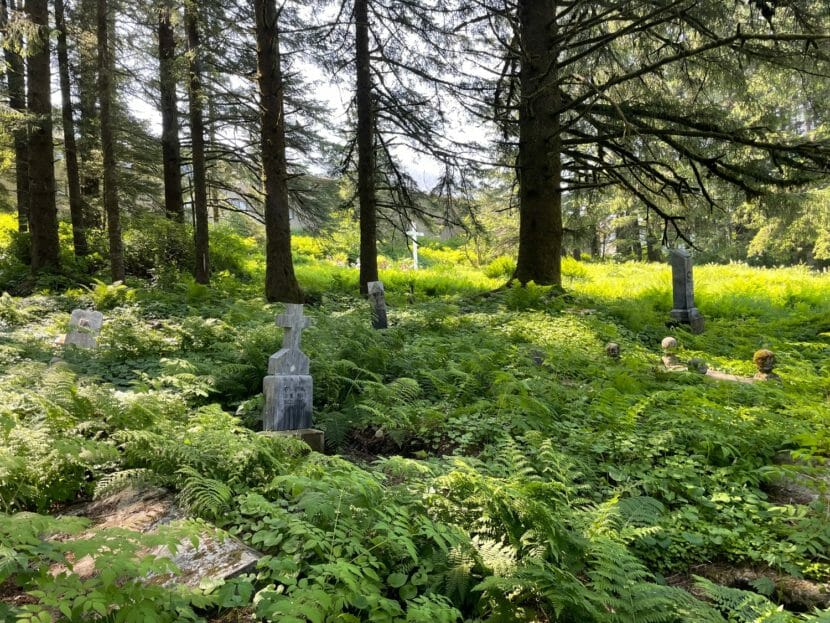
A healing process
Though the intent was to unearth and restore Native gravesites, Hasselquist and other volunteers have spent a lot of time on other neglected and forgotten resting places as well.
“We extended after we got the salmonberry bushes down from our ancestral area,” Hasselquist said.
But first, the group had to go through a healing process.
“A lot of things were said out loud, verbalized, just bringing out the frustrations about how we were not tended to and that we just will not be invisible anymore, we will be seen, they will be seen and remembered,” Hasselquist said.
“And so when we got through all of that, there was a weight lifted, and we were looking at the other areas, and we’re like, ‘Let’s go do it. Let’s start working on them.’”
Hasselquist would like to focus and work specifically on the Native section.
“But we’ve been so focused on other areas that it’s consumed our time. So if we could get others to take responsibility for the other areas, at least tending to them by mowing and weed whacking and keeping control of the salmonberry bushes and things like that because it’s just a jungle on that side.”
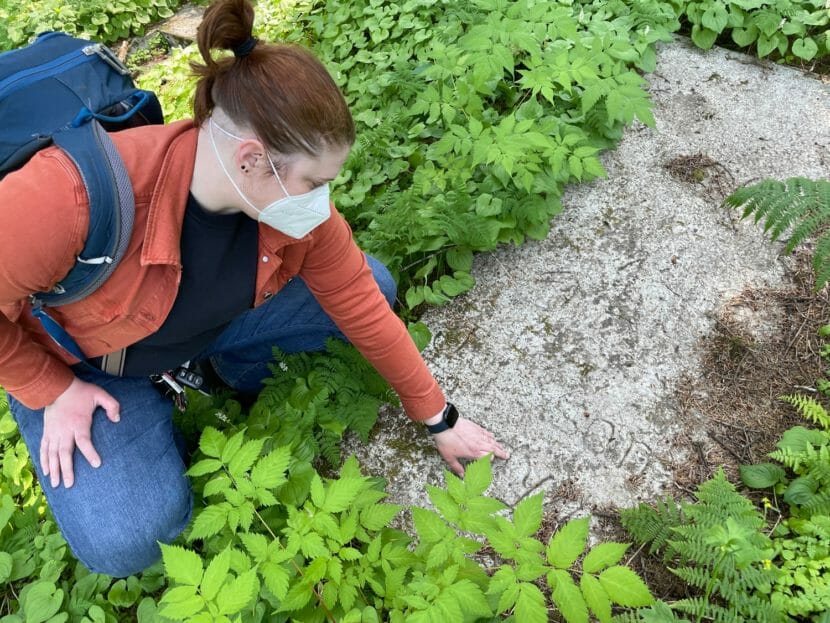
Schempf, one of the volunteers, is slowly working on a database of the cemetery that will eventually be public.
“All the information I’ve gathered is publicly available; much of it is accessible for free online. It is, however, very scattered. I’m hoping to pull it all together in a way that makes it easy for families to find their loved ones and find information about them more easily.”
“Many of the people buried in Douglas fought for recognition and respect in life, and fought to be remembered in death. It takes ongoing effort to support that, and a lot of the history of these cemeteries is already irrecoverably lost — loss of physical records, loss of living memories, and neglect of the cemeteries themselves have all played a part. It’s important to work on them now before more is lost,” Schempf said.
Whose responsibility is it?
The issue of maintaining the historic cemeteries in Douglas was most recently brought to the City and Borough of Juneau’s attention in 2018 when former mayor Merrill Sanford offered to transfer the well-maintained Eagles’ cemetery to the city at no cost with the understanding that the city would continue maintenance. The city explored what that process would entail but ultimately no action was taken. Sanford also asked the city to consider acquiring the other cemeteries in Douglas.
The cemeteries and gravesites near Lawson Creek in Douglas are owned by various parties and precise land ownership is not something the City and Borough of Juneau has ever been able to pin down.
A 2019 memo to the Lands Committee said, “There has been controversy concerning ownership of the cemeteries in Douglas since the late 1800s. Discussions about the upkeep of the cemeteries and whether or not they were city property began as early as the 1940s and the topic has been brought to the municipal governing body (Douglas City and the City & Borough of Juneau respectively) every decade since.”
According to the city, “there hasn’t been much movement” on the issue of maintaining Douglas cemeteries since the 2019 memo.
“I think this could be picked up again if the Assembly makes it a priority, which could be the outcome of citizens bringing it up,” lands and resources manager Dan Bleidorn said.
The city’s parks and recreation department currently maintains the Douglas Indian Cemetery, which is across the street from Sayéik Gastineau elementary school and set apart from the other cemeteries surrounding Lawson Creek. While the city doesn’t own it, the city’s been providing weekly maintenance of it since 2012 when a renovation at the school disturbed human remains.
Finding peace
Hasselquist said, for her, choosing to restore Native gravesites “has to do with my own personal life trauma.” The trauma stems from her ancestors and family attending residential boarding school institutions and “the things that were brought home and taken from us.” She’s the first generation of her family who didn’t attend a residential boarding school.
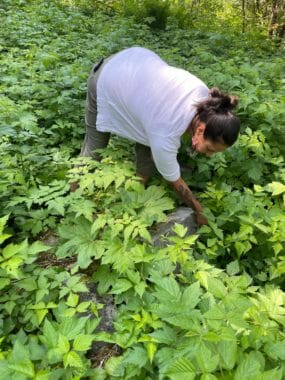
When the remains of hundreds of Indigenous children were found on the grounds of a former residential school in British Columbia last summer, Hasselquist said working on restoring gravesites “helped with the anxiety and the triggering that was happening.”
“It helps me find more peace,” she said. “And then it feels good to tend to our ancestors and take care of those places. They deserve to be resting somewhere that’s beautiful, and in honor and dignity and respect.”
The volunteers’ work has inspired others to join in through cemetery restoration and clean-up events posted on the group’s Facebook page. Hasselquist hopes to “ignite a spark” in younger people to take care of the areas.
